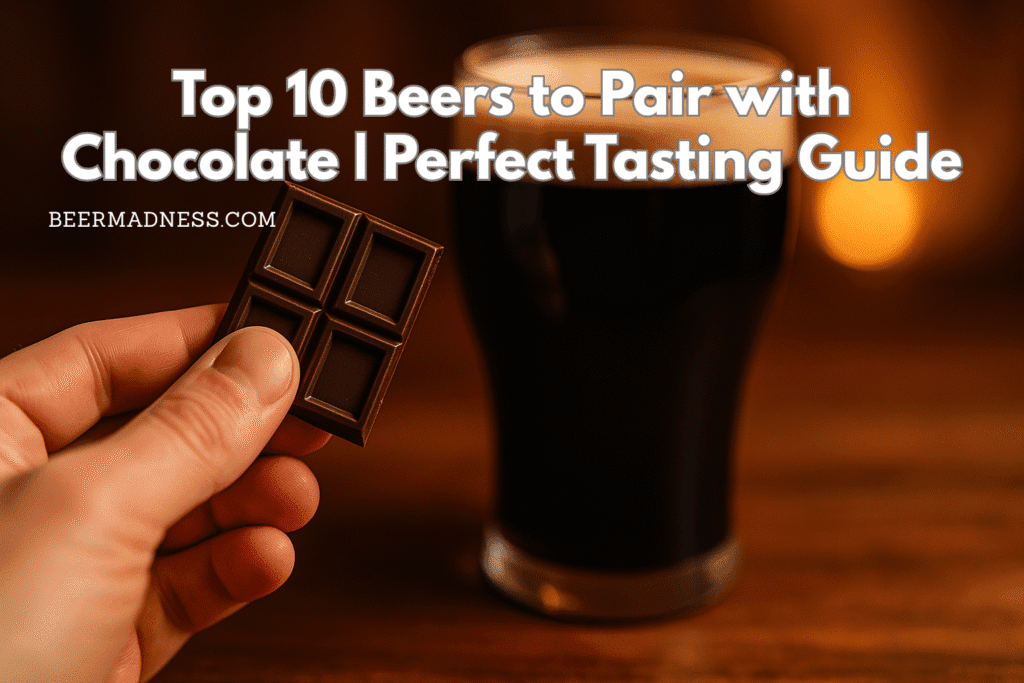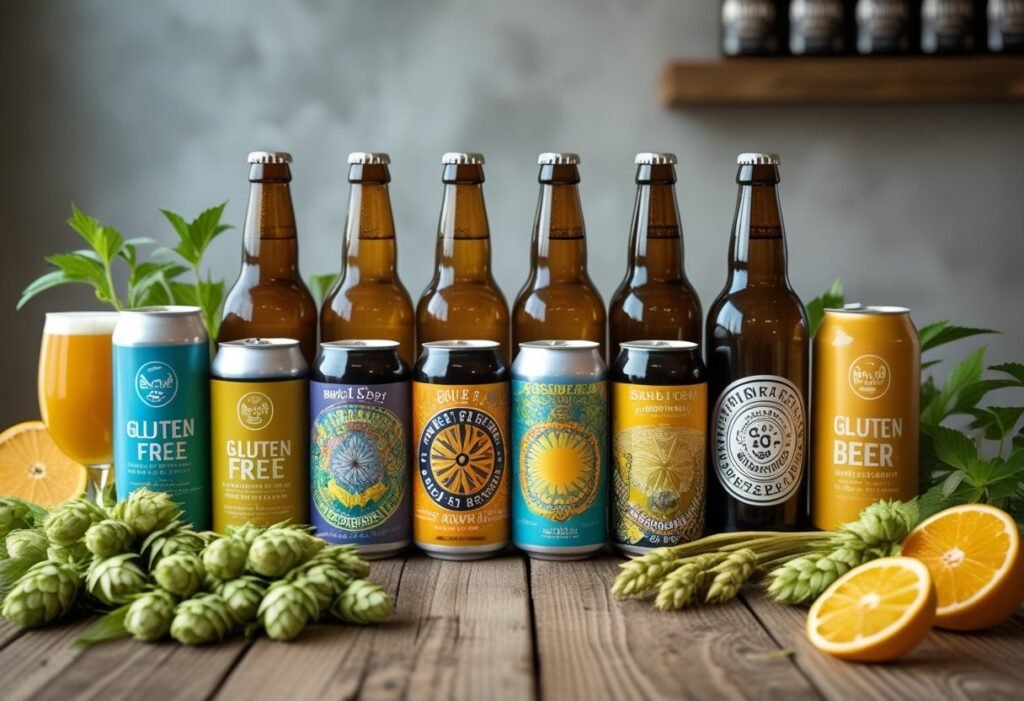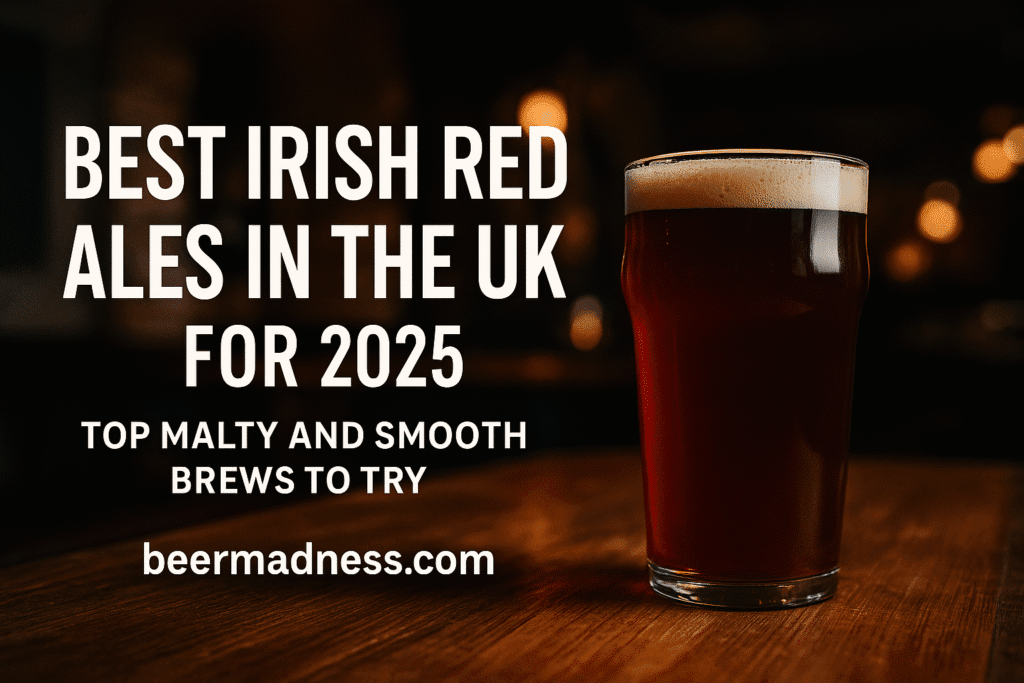Beer and chocolate might not seem like obvious partners, but when chosen carefully, they create one of the most indulgent tasting experiences you can imagine. Both are rich in complex flavors — roasted malts mirror cocoa’s bitterness, fruity esters complement sweet notes, and creamy textures enhance chocolate’s melt-in-the-mouth sensation.
In this guide to the top 10 beers to pair with chocolate, we’ll explore how different beer styles—from bold imperial stouts to fruity Belgian ales—interact with everything from dark bars to silky truffles. You’ll learn why certain pairings work so well, discover examples of world-class brews that elevate chocolate tasting, and pick up tips for hosting your own pairing session at home.
Whether you’re a seasoned craft beer enthusiast or simply curious about experimenting beyond the usual wine-and-chocolate combo, this article will give you the knowledge and inspiration to create unforgettable matches. Get ready to experience chocolate in a whole new way—through the lens of beer.
(For a deeper dive into chocolate tasting principles, resources like the Fine Chocolate Industry Association offer valuable insights into flavor profiles.)
This post may contain affiliate links. If you click and purchase, I may receive a small commission at no extra cost to you. Learn more
Why Beer and Chocolate Are a Match Made in Heaven
Pairing beer with chocolate works because both share complex flavor compounds that can complement or contrast beautifully. At the heart of the pairing is balance: the roasted malts in many beers mirror the bitter richness of cocoa, while the sweetness of milk chocolate finds harmony with smooth, creamy beer styles.
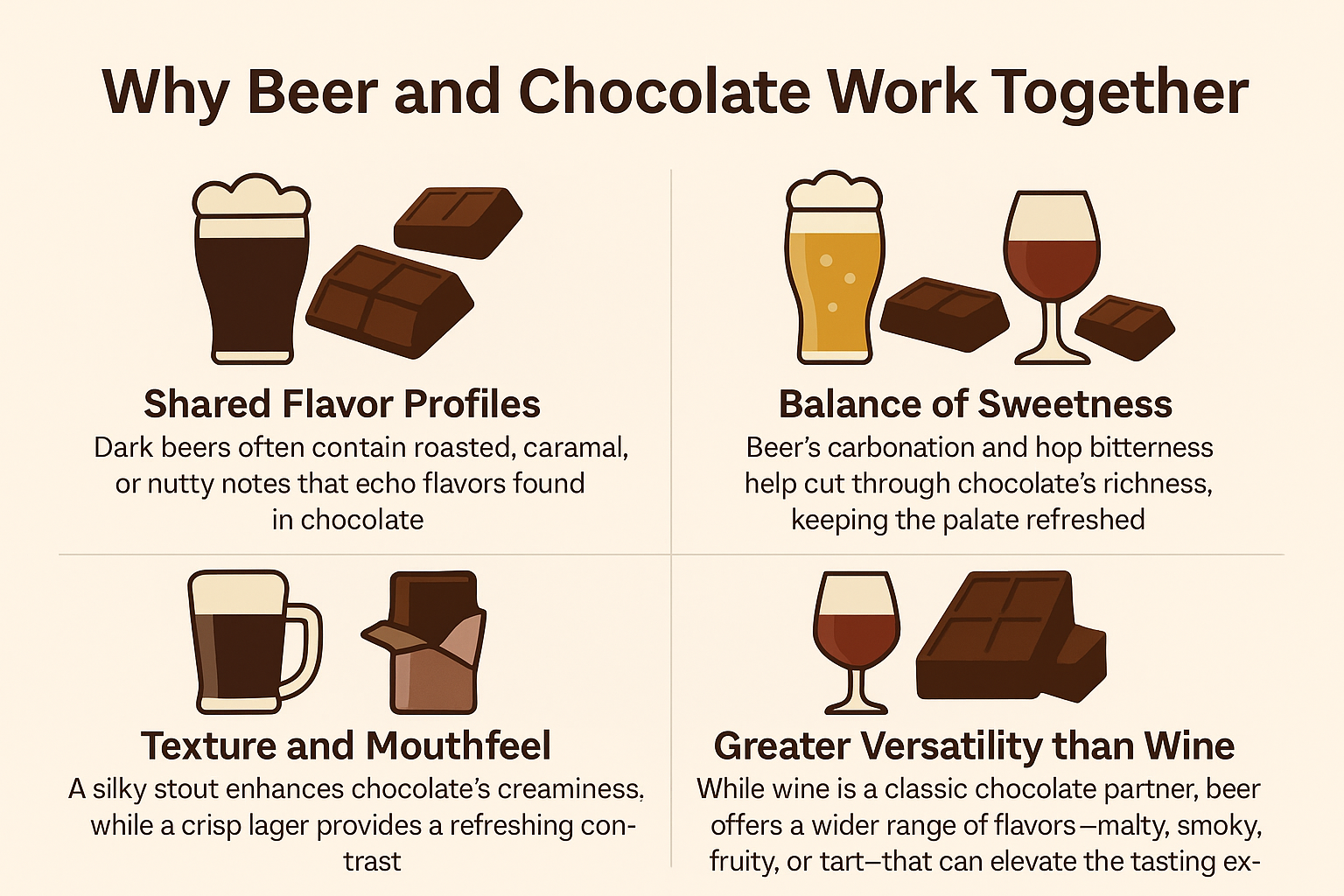
Here are the main reasons why beer and chocolate go so well together:
- Shared Flavor Profiles: Dark beers often contain roasted, caramel, or nutty notes that echo flavors found in chocolate.
- Balance of Sweetness and Bitterness: Beer’s carbonation and hop bitterness help cut through chocolate’s richness, keeping the palate refreshed.
- Texture and Mouthfeel: A silky stout enhances chocolate’s creaminess, while a crisp lager provides a refreshing contrast.
- Greater Versatility than Wine: While wine is a classic chocolate partner, beer offers a wider range of flavors—malty, smoky, fruity, or tart—that can elevate the tasting experience.
In fact, many beer experts argue that beer is more versatile than wine when paired with chocolate. The combination of carbonation, malt sweetness, and varied yeast-driven flavors creates endless opportunities for creative matches.
For example, a roasty porter paired with a square of dark chocolate can highlight layers of espresso and cocoa, while a Belgian Dubbel with praline chocolate reveals caramel and spice notes. This kind of flavor interplay is what makes beer and chocolate such a perfect match for tasting experiences.
(If you’re curious about the science behind beer and flavor, the Beer Flavor Wheel by the American Society of Brewing Chemists is a great visual resource.)
How to Pair Beer with Chocolate Like a Pro
Pairing beer and chocolate is part art, part science. While there’s no single “right” way, following a few simple principles will help you create matches that truly shine. Think of it as balancing flavor intensity, sweetness, and texture so that neither element overwhelms the other.
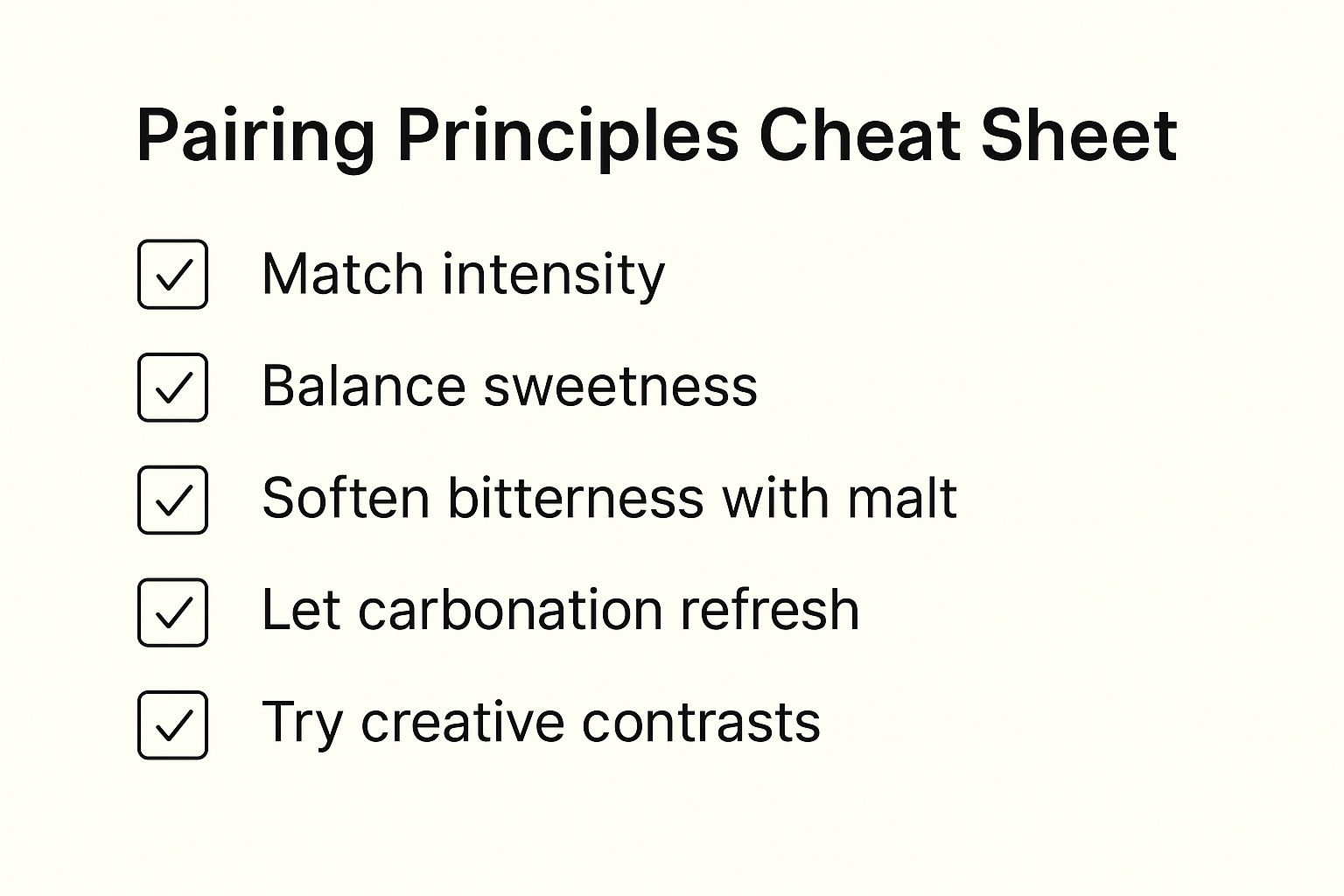
Consider the Intensity
Match light beers with delicate chocolates and bold beers with richer, darker varieties. A crisp pilsner works well with white chocolate, while an imperial stout has the power to stand up to 80% dark cacao.
Match Sweetness Levels
If the beer is drier than the chocolate, it can taste harsh. Choose beers that meet or exceed the sweetness of the chocolate for a smoother pairing. Milk stouts and chocolate truffles are a natural duo for this reason.
Balance Bitterness and Acidity
Chocolate with high cacao content can be quite bitter. Pair it with beers that balance bitterness—such as a malty porter—or contrast it with tart, fruity beers like a cherry lambic.
Experiment with Contrasts
Sometimes opposites attract. A smoky rauchbier with chili-infused chocolate or a sour framboise with creamy white chocolate can create unexpected, memorable flavor explosions.
If you want a shortcut, remember these five rules for pairing beer with chocolate:
- Match intensity (light with light, bold with bold).
- Keep sweetness levels balanced.
- Use malt to soften bitterness.
- Let carbonation refresh the palate.
- Don’t fear creative contrasts.
Following these principles will make the top 10 beers to pair with chocolate (which we’ll cover next) easier to understand and even more enjoyable when you try them at home.
(For more tasting advice, see the CraftBeer.com guide to beer and food pairing.)
Top 10 Beers to Pair with Chocolate
When it comes to indulgence, few combinations rival beer and chocolate. Below you’ll find the top 10 beers to pair with chocolate, each selected for its ability to highlight unique cocoa flavors and textures.
1. Imperial Stout – Bold Intensity with Dark Chocolate
Why it works:
Imperial stouts are known for their high ABV, dense body, and flavors of roasted coffee, burnt caramel, and bittersweet chocolate. These bold beers naturally amplify the richness of dark chocolate while balancing its bitterness.
Best chocolate match:
- 70–85% dark chocolate bars
- Dark chocolate-covered espresso beans
Example pairing:
- Goose Island Bourbon County Stout (USA) with a square of 80% cacao dark chocolate
- Samuel Smith’s Imperial Stout (UK) with a slice of flourless chocolate cake
The roasted malt backbone mirrors cacao’s deep bitterness, while residual sweetness smooths out sharp edges. The combination creates a tasting experience that lingers with luxurious intensity.
2. Milk Stout – Creamy Harmony with Milk Chocolate
Why it works:
Milk stouts contain lactose sugar, which adds a creamy sweetness that softens roasted flavors. This makes them a perfect match for milk chocolate, echoing its silky texture and caramel notes.
Best chocolate match:
- Creamy milk chocolate bars
- Chocolate truffles and pralines
Example pairing:
- Left Hand Milk Stout Nitro (USA) with a soft milk chocolate truffle
- Lancaster Black (UK) with hazelnut praline chocolate
The natural sweetness of milk stout complements the sugar content of milk chocolate without overwhelming it. Together, they form a smooth, dessert-like pairing that feels indulgent yet balanced.
3. Porter – Roasty Depth with Semi-Sweet Chocolate
Why it works:
Porters are slightly lighter than stouts but still bring roasted malt, coffee, and nutty flavors to the glass. Their moderate body and balanced bitterness make them versatile partners for chocolate, especially semi-sweet varieties that don’t overpower the beer.
Best chocolate match:
- Semi-sweet chocolate (around 60% cacao)
- Chocolate-dipped biscotti
Example pairing:
- Fuller’s London Porter (UK) with semi-sweet chocolate bark
- Founders Porter (USA) with chocolate biscotti
The roasted character of the porter brings out nutty undertones in chocolate, while its gentle carbonation helps cleanse the palate between bites. This pairing is especially popular for those who enjoy a touch of roast without the heaviness of an imperial stout.
4. Barleywine – Rich Sweetness with Chocolate Truffles
Why it works:
Barleywines are strong, malt-forward beers with flavors of caramel, toffee, and dried fruits. Their sweetness and warming alcohol content create a luxurious pairing with rich chocolate desserts, especially truffles.
Best chocolate match:
- Dark chocolate truffles
- Chocolate fudge or caramel-filled chocolates
Example pairing:
- Sierra Nevada Bigfoot Barleywine (USA) with dark chocolate truffles
- JW Lees Harvest Ale (UK) with chocolate fudge squares
The deep malt sweetness of barleywine enhances chocolate’s richness, while fruity notes highlight subtle flavors like cherry or raisin often found in cocoa. The result is a pairing that feels indulgent and almost brandy-like in complexity.
5. Belgian Dubbel – Caramel & Spice with Praline Chocolate
Why it works:
Belgian Dubbels are medium-strong, malt-driven ales with flavors of caramel, dark fruit, and gentle spice from Belgian yeast. These complex notes align beautifully with nut-filled or praline chocolates, where caramel and roasted nut flavors shine.
Best chocolate match:
- Hazelnut praline chocolates
- Caramel-filled milk chocolates
Example pairing:
- Westmalle Dubbel (Belgium) with hazelnut praline chocolate
- Chimay Première (Red) (Belgium) with caramel-centered milk chocolate
The beer’s caramel backbone melds with nutty sweetness, while subtle clove and spice notes elevate the chocolate’s depth. This pairing feels warm, cozy, and balanced — an excellent choice for winter evenings.
6. Belgian Quadrupel – Fruity Complexity with Chocolate Cake
Why it works:
Belgian Quadrupels (Quads) are strong, dark ales bursting with flavors of dried figs, plums, toffee, and warming alcohol. Their depth makes them perfect companions to dense chocolate desserts, especially cake or brownies.
Best chocolate match:
- Flourless chocolate cake
- Chocolate brownies with nuts
Example pairing:
- Rochefort 10 (Belgium) with flourless dark chocolate cake
- La Trappe Quadrupel (Netherlands) with walnut brownies
The Quad’s fruity esters bring out dried-fruit flavors in the cocoa, while its caramel sweetness softens any bitterness. Combined with chocolate cake, this pairing delivers layers of richness that linger long after each bite.
7. Rauchbier – Smoky Adventure with Chili Chocolate
Why it works:
Rauchbier, a traditional smoked beer from Bamberg, Germany, offers bold flavors of campfire smoke, roasted malt, and earthy depth. These smoky notes create a dramatic contrast with spicy chili chocolate, where heat and smoke intertwine.
Best chocolate match:
- Dark chocolate infused with chili
- Chocolate bars with smoked sea salt
Example pairing:
- Aecht Schlenkerla Märzen (Germany) with chili dark chocolate
- Specialty craft Rauchbiers with smoked sea salt chocolate bark
The smokiness of the beer intensifies the chili’s heat while cocoa richness tempers the spice. This pairing is bold, unique, and perfect for adventurous palates who enjoy unexpected flavor experiences.
8. Fruit Lambic (Kriek or Framboise) – Tart Contrast with White Chocolate
Why it works:
Fruit Lambics, particularly Kriek (cherry) and Framboise (raspberry), bring bright acidity, tart fruit, and subtle sweetness. Their lively, sparkling character cuts through the sweetness of white chocolate, preventing it from feeling cloying.
Best chocolate match:
- White chocolate bars
- White chocolate-dipped strawberries
Example pairing:
- Lindemans Framboise (Belgium) with white chocolate bark
- Boon Kriek (Belgium) with white chocolate-covered strawberries
The fruity tartness balances the rich creaminess of white chocolate, while carbonation refreshes the palate. This combination feels light, playful, and is often a crowd-pleaser at tastings.
9. Coffee Beer – Espresso Edge with Mocha Chocolate
Why it works:
Coffee beers—often stouts or porters brewed with real coffee—deliver roasted espresso, cocoa, and sometimes nutty flavors. These bold notes blend seamlessly with mocha or coffee-infused chocolate, creating a pairing that feels harmonious and layered.
Best chocolate match:
- Mocha chocolate bars
- Chocolate-covered espresso beans
Example pairing:
- Founders Breakfast Stout (USA) with mocha chocolate
- Mikkeller Beer Geek Breakfast (Denmark) with chocolate-covered espresso beans
The shared roasted bitterness enhances depth, while a touch of sweetness in the chocolate softens the edges. Together, beer and chocolate become an elevated version of a classic mocha.
10. Pastry Stout – Dessert Explosion with Chocolate Brownies
Why it works:
Pastry stouts are modern craft creations that incorporate dessert-inspired flavors such as vanilla, caramel, peanut butter, or even marshmallow. Their sweetness and thickness make them perfect for pairing with rich, fudgy chocolate desserts.
Best chocolate match:
- Chocolate brownies
- Chocolate lava cake
Example pairing:
- Omnipollo Noa Pecan Mud Cake Stout (Sweden) with chocolate brownies
- 3 Floyds Moloko (USA) with chocolate lava cake
The beer’s dessert-like qualities amplify the richness of the chocolate, creating a decadent, almost over-the-top pairing. This is the ultimate treat for anyone with a sweet tooth.
Want to taste these pairings for yourself? Many of the beers featured in this list are available to order online from Beers of Europe, one of the UK’s largest beer marketplaces. Stock up before your chocolate & beer tasting for the full experience.
Quick Summary: Top 10 Beers to Pair with Chocolate
| Beer Style | Best Chocolate Match | Example Pairing |
|---|---|---|
| Imperial Stout | 70–85% dark chocolate, espresso beans | Goose Island Bourbon County Stout (USA) + 80% cacao chocolate |
| Milk Stout | Milk chocolate, pralines | Left Hand Milk Stout Nitro (USA) + milk chocolate truffle |
| Porter | Semi-sweet chocolate, chocolate biscotti | Fuller’s London Porter (UK) + semi-sweet chocolate bark |
| Barleywine | Dark chocolate truffles, fudge | JW Lees Harvest Ale (UK) + chocolate fudge |
| Belgian Dubbel | Hazelnut praline, caramel-filled milk chocolate | Westmalle Dubbel (Belgium) + hazelnut praline |
| Belgian Quadrupel | Flourless chocolate cake, brownies | Rochefort 10 (Belgium) + flourless dark chocolate cake |
| Rauchbier | Chili chocolate, smoked sea salt bars | Aecht Schlenkerla Märzen (Germany) + chili dark chocolate |
| Fruit Lambic | White chocolate, chocolate-dipped strawberries | Lindemans Framboise (Belgium) + white chocolate bark |
| Coffee Beer | Mocha chocolate, espresso beans | Founders Breakfast Stout (USA) + mocha chocolate |
| Pastry Stout | Chocolate brownies, lava cake | Omnipollo Noa Pecan Mud Cake (Sweden) + brownies |
Hosting a Chocolate & Beer Tasting
Pairing chocolate with beer is even more fun when shared with friends. Hosting a tasting session allows you to explore different flavor combinations side by side, making the experience both social and educational. With just a little preparation, you can turn an evening into an unforgettable sensory journey.
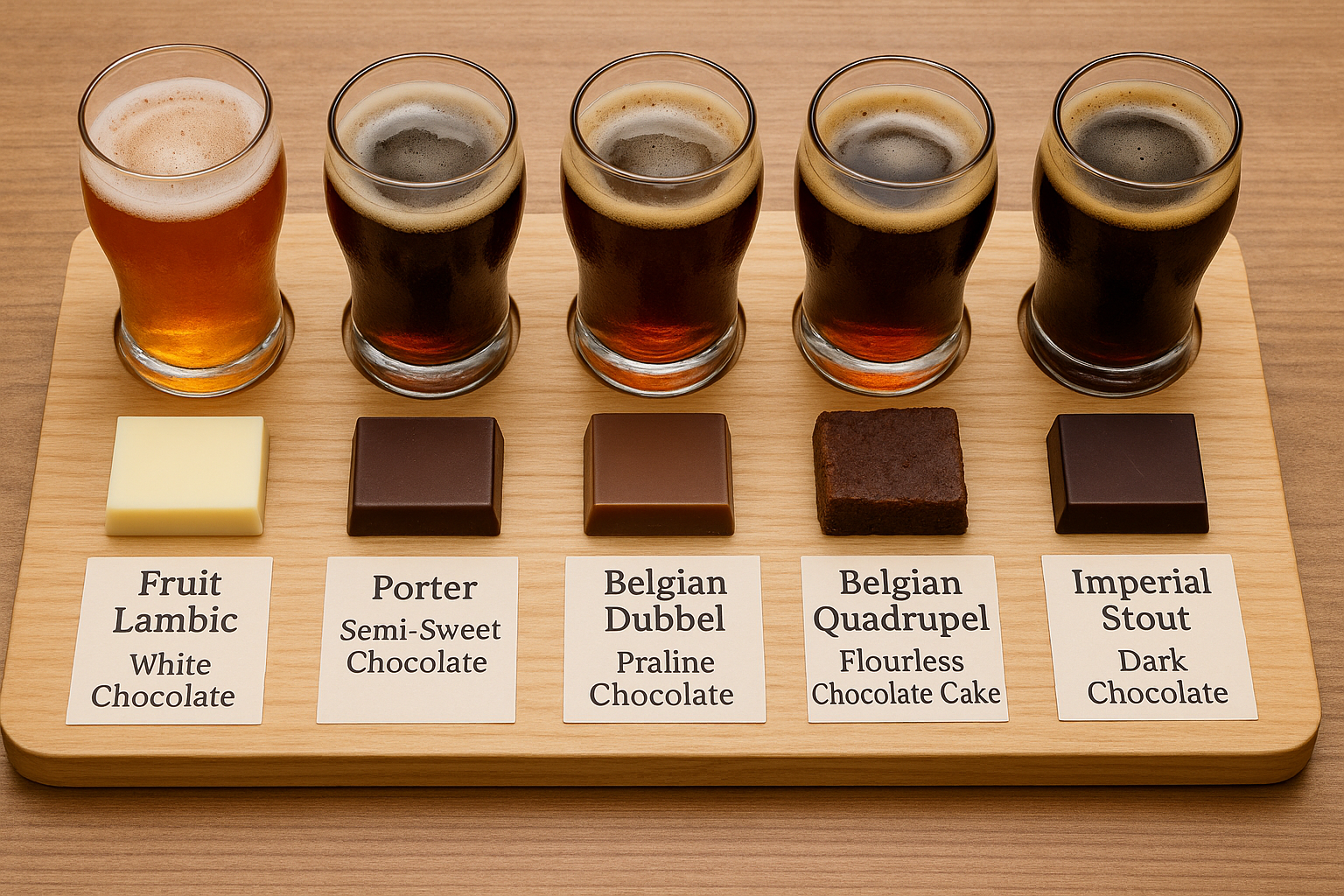
Structure Your Flight
Arrange the beers from lightest to strongest in flavor and alcohol content. For example: start with a fruit lambic and finish with an imperial stout or pastry stout. This progression keeps palates fresh and avoids overwhelming the early pairings.
Serving Tips
- Temperature: Serve most beers between 8–12°C (46–54°F) to highlight aromas and flavors. Keep lighter beers a bit cooler and stronger ales slightly warmer.
- Glassware: Use small tasting glasses or snifters. This enhances aroma while keeping pours manageable.
- Chocolate Prep: Break chocolates into bite-sized pieces and place them on a tasting board or plate, labeled by cacao percentage or flavor.
Suggested Pairing Order
- Fruit Lambic with white chocolate
- Porter with semi-sweet chocolate
- Belgian Dubbel with praline chocolate
- Belgian Quadrupel with flourless chocolate cake
- Imperial Stout with dark chocolate
This mix ensures a balance of contrasts and harmonies throughout the session.
“If you love pairing beer with food, don’t miss our guide on BBQ and Beer Pairing: 2025 Summer Guide to Perfect Grilled Food Matches.”
“Want to experience professional pairings before hosting your own? Book a guided beer & chocolate tour on Viator to taste with experts and discover local specialties.”
Common Mistakes to Avoid
Even the best chocolate and beer can clash if the pairing isn’t chosen carefully. Here are some common pitfalls to watch out for when exploring the top beers to pair with chocolate:
- Overpowering Pairings: Putting a delicate white chocolate next to a strong imperial stout can overwhelm its subtle flavors. Always try to match intensity.
- Ignoring Sweetness Levels: If the beer is drier than the chocolate, the contrast can taste harsh or sour. Make sure the beer matches or slightly exceeds the sweetness.
- Forgetting About Texture: A thick, chewy brownie paired with a heavy pastry stout might feel too dense. Use carbonation or lighter beers to refresh the palate.
- Skipping Carbonation: Beers with gentle fizz cleanse the mouth between bites, while flat pairings can feel heavy.
- Not Experimenting Enough: Sticking only to “safe” choices limits discovery. Contrasts like smoky beers with chili chocolate can surprise and delight.
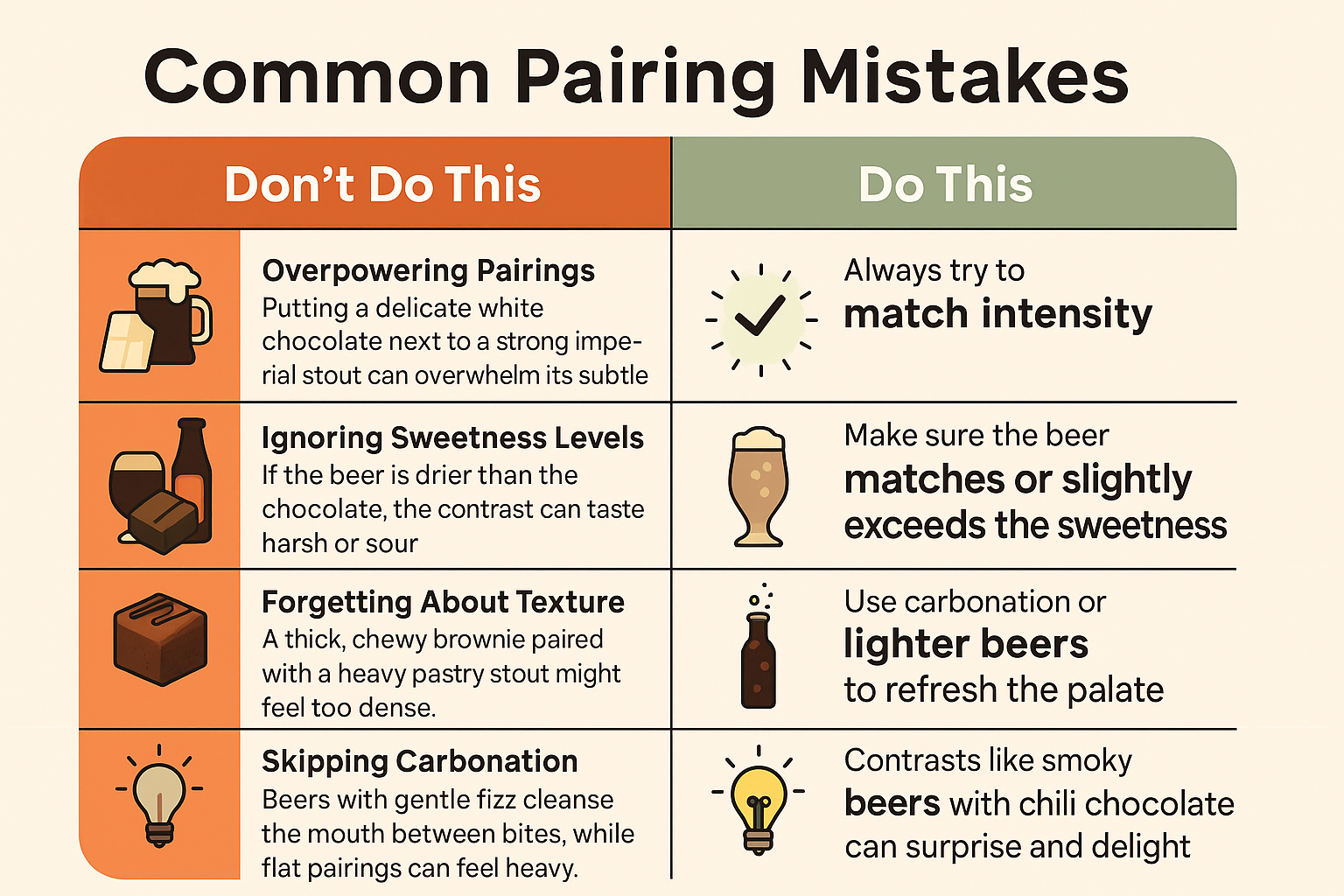
By avoiding these mistakes, you’ll make sure your tasting feels balanced, enjoyable, and memorable — instead of overwhelming.
Frequently Asked Questions (FAQ)
Can you really pair any chocolate with beer?
Yes, but success depends on matching intensity and sweetness. For example, delicate white chocolate is best with fruit lambics or milk stouts, while bold dark chocolate pairs better with imperial stouts or barleywines.
What beer goes best with dark chocolate?
Dark chocolate (70–85% cacao) pairs beautifully with imperial stouts, porters, or barleywines. Their roasted malts and caramel sweetness balance chocolate’s natural bitterness.
Is beer and chocolate pairing better than wine?
Many experts say yes. While wine is a classic option, beer’s carbonation and broader flavor range—from smoky to sour—make it more versatile with chocolate.
Can I pair white chocolate with beer?
Absolutely. White chocolate’s creamy sweetness works best with fruit lambics, milk stouts, or Belgian blondes. The acidity or light sweetness of these beers prevents the pairing from feeling overly rich.
What’s the best way to host a pairing at home?
Keep pours small, move from lighter to stronger beers, and provide a variety of chocolates (milk, dark, white, flavored). Encourage guests to note aromas, textures, and flavors for a more engaging experience.
Do alcohol-free beers work with chocolate?
Yes. Many non-alcoholic stouts and porters still deliver roasted malt character, which pairs well with milk or dark chocolate. Fruity alcohol-free beers also complement white chocolate nicely.
“For at-home tastings, you don’t need much—just good chocolate, great beer, and the right glassware. You can find affordable beer tasting glass sets on Amazon to elevate the experience.”
Final Thoughts & Next Steps
Pairing beer with chocolate may sound unconventional, but once you experience the harmony between roasted malts, creamy textures, and sweet cocoa, it becomes unforgettable. From bold imperial stouts with dark chocolate to playful fruit lambics with white chocolate, the possibilities are endless.
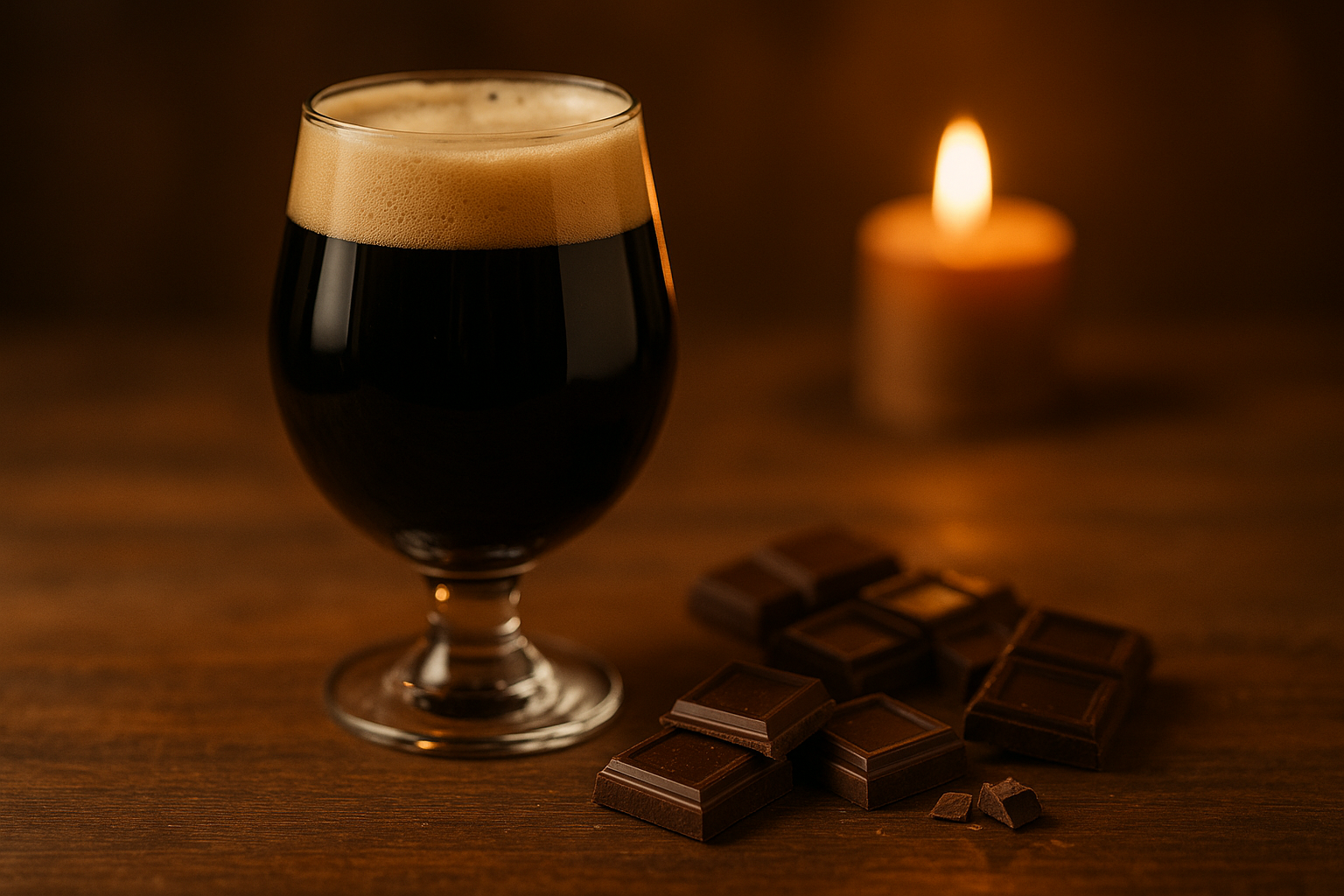
The key is to balance intensity, sweetness, and texture. Start with a few pairings from this guide, experiment at home, and don’t be afraid to try unexpected contrasts. Every palate is unique, and the joy of pairing comes from discovering your own favorites.
If you enjoyed exploring the top 10 beers to pair with chocolate, you’ll love diving deeper into other beer experiences. Looking for more pairing inspiration? Check out our list of 10 Perfect Cheese and Beer Pairings Every Homebrewer Needs to Try (2025 Guide).”
👉 Ready to keep your beer knowledge flowing? Subscribe to the Beer Madness newsletter for pairing tips, brewery spotlights, and beer travel ideas straight to your inbox.

